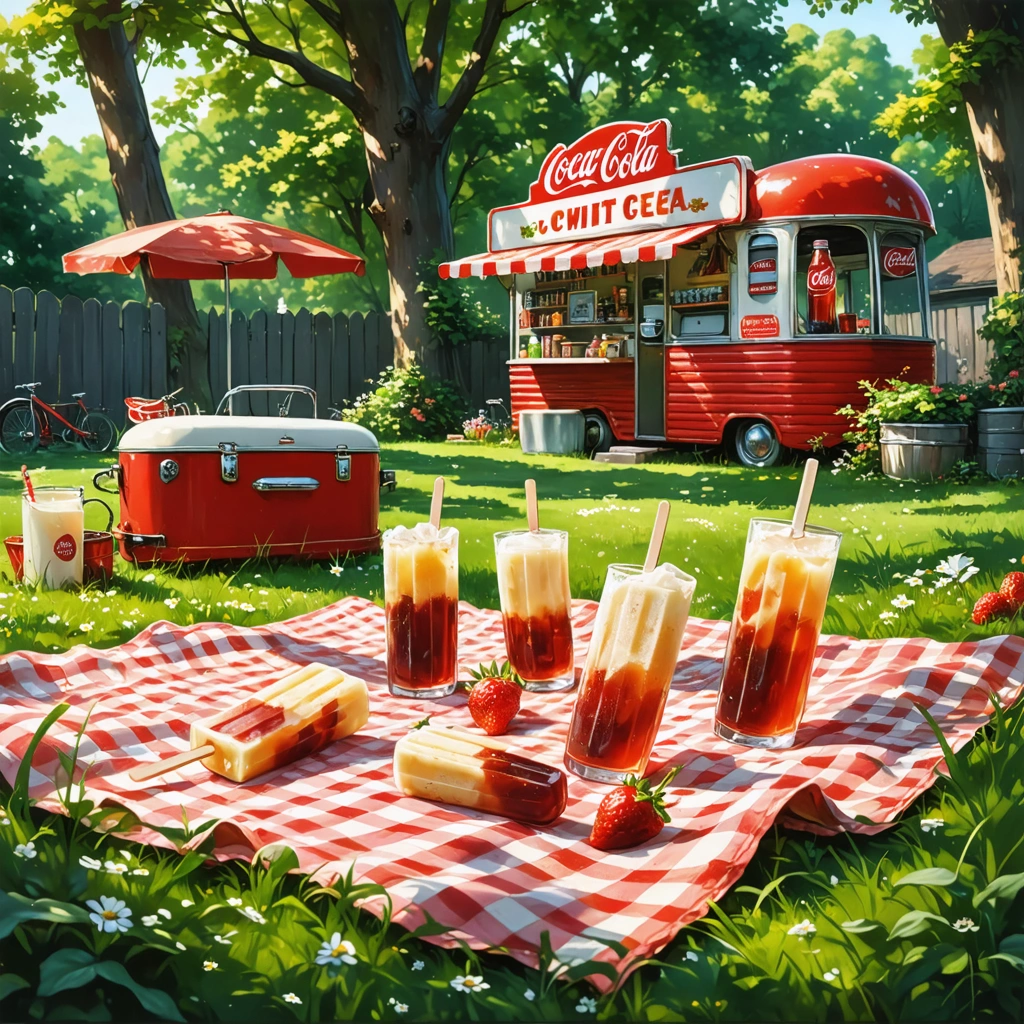When Childhood Memories Meet Refreshing Marketing
Remember the simple joy of biting into a cola ice pop on a scorching summer afternoon? That perfect blend of icy chill and fizzy cola flavor, instantly transporting you back to carefree days and sun-drenched weekends. Yet, in today’s fast-paced world, where new snack trends pop up overnight, the charm of these nostalgic treats sometimes feels overshadowed. The craving for that unmistakable taste of coke flavored ice cream or cola flavored ice cream isn’t just about flavor; it’s a connection to a time when branding was fun, colorful, and full of personality. But how does one capture that sentiment while appealing to modern sensibilities?
It’s a challenge that beverage and frozen dessert brands wrestle with constantly. Traditional soda flavors like Coca-Cola have a legacy of iconic branding, yet translating that into frozen treats requires more than just slapping a logo on a popsicle. The coca cola flavored ice cream category, for instance, has seen waves of popularity, but sustaining consumer interest demands fresh creativity. How do you market a frozen treat that’s both a delightful refreshment and a sentimental journey?
Why Frozen Cola Treats Are More Than Just Nostalgia
Sure, nostalgia is powerful — it tugs at the heartstrings and sparks emotional buying decisions. But relying solely on that can limit a brand’s reach. Younger generations, who might be more familiar with digital icons like the cola emoji than the classic glass bottle, crave experiences that feel authentic yet contemporary. The marketing of cola ice pops must evolve to capture this cross-generational appeal.
Think about the packaging design or the way these products are advertised: retro aesthetics can evoke a vintage charm, but pairing them with sleek, modern branding elements appeals to today’s trend-savvy consumers. It’s a balancing act — one that merges the rich history of cola’s fizzy delight with the innovative spirit of today’s frozen dessert market.
What This Article Will Explore
In the sections that follow, we’ll dive into how cola ice pops and their frozen cousins like coke flavored ice cream are crafted not just to satisfy taste buds but to tell stories. We’ll explore:
- The evolution of cola flavored ice cream as a product category and its cultural significance
- How classic beverage branding elements are reimagined in frozen treat marketing
- The role of nostalgia and modern design trends in attracting diverse customer bases
- Examples of successful campaigns that have bridged the old and new effectively
If you’ve ever wondered why the simple cola ice pop can still steal the spotlight amidst a sea of exotic flavors, or how the coca cola flavored ice cream manages to evoke smiles across generations, this article is for you. Whether you’re a marketer, a frozen treat enthusiast, or someone curious about the intersection of branding and nostalgia, get ready to discover the frosty magic behind one of the most beloved summertime icons.

Cola Ice Pop Nostalgia: The Intersection of Retro Vibes and Refreshing Beverage Branding
What Makes Cola Ice Pops So Nostalgic and Popular?
The cola ice pop is a frozen treat that taps deeply into both nostalgic memories and modern branding strategies. These popsicles mimic the familiar, beloved flavor of cola beverages, evoking childhood summer days and classic soda fountain experiences. The nostalgia associated with cola ice pops comes from their ability to blend the iconic taste of cola—often reminiscent of the original Coca-Cola or similar brands—with a fun, frozen texture.
Brands capitalize on this by invoking retro vibes in their packaging and marketing. Vintage typography, classic color schemes (think red, white, and black), and imagery reminiscent of mid-20th century soda shops create emotional connections with consumers. This nostalgia encourages repeat purchases and social sharing, especially among millennials and Gen Z consumers who appreciate throwback trends.
How Do Cola Ice Pops Fit Into Frozen Treat and Beverage Branding?
Cola ice pops represent a smart fusion of frozen treat innovation and beverage branding. By taking a popular drink flavor and transforming it into a frozen form, companies expand their product portfolio while enhancing brand recognition. This approach works because:
- Flavor Familiarity: Consumers are more likely to try a new product if it features a flavor they already enjoy, such as the classic cola taste.
- Visual Branding: Using iconic cola imagery and even the cola emoji in digital marketing helps create a cohesive brand story and makes the product easily identifiable.
- Emotional Engagement: Nostalgia marketing taps into consumers’ positive memories, making the product feel comforting and trustworthy.
For example, a cola ice pop brand might design packaging that mimics a vintage soda bottle label or use retro fonts. Such branding techniques create a sense of authenticity and heritage that consumers find appealing.
What Are the Differences Between Cola Ice Pop and Cola Flavored Ice Cream Variants?
While both cola ice pops and cola flavored ice cream products share the same flavor inspiration, they differ in texture, consumption experience, and target audience:
- Cola Ice Pop: Typically a frozen liquid on a stick, offering a refreshing, icy texture. It’s perfect for hot weather and quick consumption.
- Coke Flavored Ice Cream / Coca Cola Flavored Ice Cream / Cola Flavored Ice Cream: These are creamier, richer desserts that blend cola flavor with dairy. They appeal to consumers seeking a more indulgent treat.
Ice cream versions often incorporate real cola syrup or flavor extracts, balancing sweetness and tanginess with creamy mouthfeel. Brands like Coca-Cola have officially licensed ice cream products that showcase how beverage companies can extend their flavor into frozen dessert categories. This cross-category branding increases consumer touchpoints and loyalty.
Why Is the Cola Emoji Important in Marketing Cola Ice Pops?
The cola emoji serves as a modern digital shorthand that helps brands engage audiences on social media and messaging platforms. Using the cola emoji in campaigns related to cola ice pops or cola flavored ice cream can:
- Make posts visually appealing and instantly recognizable
- Encourage user interaction through relatable and fun content
- Boost brand recall by associating the emoji with the product
In an era where emojis shape how younger demographics communicate, incorporating the cola emoji bridges traditional branding with contemporary digital culture. It’s a subtle but effective tool in expanding reach and increasing engagement.
Industry Insights and Case Studies
According to market research, the frozen dessert segment has seen a steady growth rate of around 4% annually, with novelty and nostalgic products leading the charge. Brands like Popsicle and novelty ice cream makers have reported that limited-edition cola-flavored products generate buzz and higher sales.
For instance, Coca-Cola’s collaboration with ice cream brands to produce coca cola flavored ice cream lines has driven significant seasonal interest, leading to spikes in both in-store and online sales. These partnerships illustrate how beverage brands can leverage their flavor profiles creatively in frozen treats, satisfying consumer demand for both novelty and familiarity.
Summary: Why Cola Ice Pops Represent More Than Just a Frozen Treat
Cola ice pops are a perfect example of how brands can marry nostalgic appeal with innovative product development. They capitalize on the universal love for cola-flavored beverages while delivering a fun, refreshing experience. Integrating elements like the cola emoji into marketing enhances digital engagement, while expanding into cola flavored ice cream variants appeals to diverse consumer preferences.
Ultimately, the success of cola ice pops and their related products hinges on strong branding, emotional resonance, and strategic use of flavor familiarity—making them a compelling study in frozen treat branding and beverage marketing.



